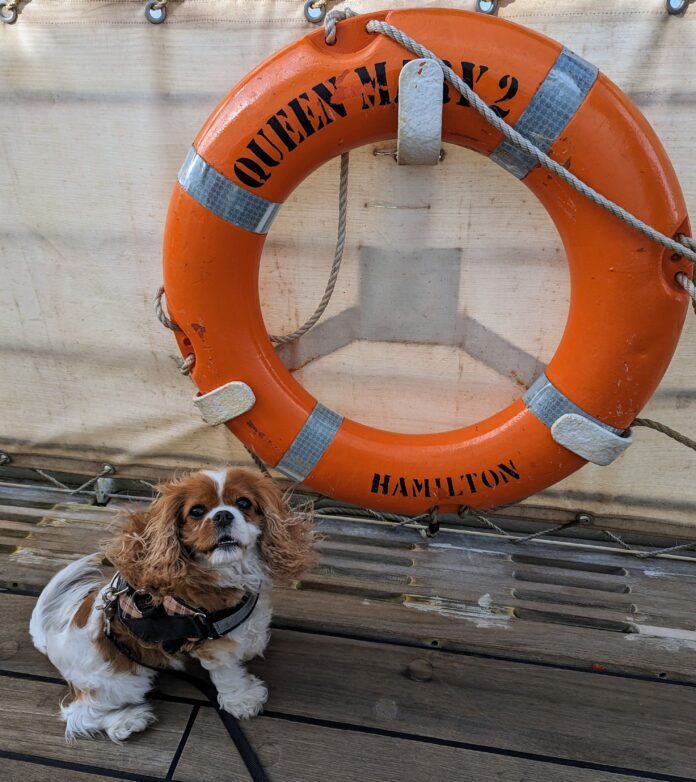The biggest misconception about taking a dog to Europe or other overseas destinations is that a lengthy quarantine stay is mandatory. That’s old news, but there are still multiple hoops to jump through before you and your dog can jet off to an international locale, whether for a move, a vacation, or specialized pet medical care (yes, that’s a thing).
My husband and I recently put into play a longstanding plan to spend several months exploring Europe—and of course that meant taking our dog Sparkles along. Here’s what we learned about how to travel with a dog internationally, from planning to pitfalls, and how to avoid the latter. It’s not easy or inexpensive, but if you’re planning to stay for more than a month or to make a permanent move, it’s worth the effort.
Before you make travel reservations and start packing your bags, take into account the following 9 factors:
- Destination(s) and how to get there
- Size of dog and carrier
- Pet travel documents
- Packing for your pet
- Food and medication
- Where to stay
- Dog-friendly activities
- Finding a pet sitter when necessary
- Getting back home
Doing research ahead of time, especially on the first four items, will save you a lot of anxiety and, potentially, money.
I See London, I See France
Where you’re going plays a huge role in determining your mode of travel. If you’ve been dreaming of taking your dog to Great Britain and have heard that there’s no longer a six-month quarantine, that doesn’t mean that taking your dog there will be a walk in Hyde Park. Britain has strict guidelines for pet entry. On flights to the United Kingdom, pets may not fly in the cabin but must be transported in cargo. The only exceptions are specific types of assistance or service dogs. (Those requirements aren’t addressed in this article, but more information is available at https://www.gov.uk/government/publications/travel-with-assistance-dogs-transport-companies-and-routes.)
You can only enter the UK directly with your dog if you’re traveling by private jet, including pet-friendly carriers such as Bark Air, or crossing the pond on the ocean liner Queen Mary 2, which has popular pet kennels that are generally booked a year or more in advance.
Start planning now if an Atlantic crossing is the way you want to go. Even though I knew our timeline wouldn’t allow for it, I looked into it just to see how it works. Travelers must reserve a cabin for a specific date first and then call to see if a pet kennel is available. If not, they’ll be placed on a waiting list and contacted when a spot is available. Flexibility is essential. Getting a pet spot can take up to two years or it can happen very quickly if someone cancels a reservation.
How to Travel With a Dog By Plane

Unless you have a NetJets membership, private jet charters are usually put together with a group of other pet lovers who also want to get to the UK or other destinations without flying their pets in cargo. To find potential charters, usually to the EU or UK, look for Facebook groups such as Chartered Air Travel With Pets. Finding the right charter that works for your destination and dog, not to mention budget, can take months of planning.
Bark Air has a regular schedule of flights to London and Paris and is planning to add other European destinations. It’s pricey, with flights from $8,000 and up each way, but there are no limitations on dog size. (They fly cats, too, if they’re in a carrier and vouched for by an accompanying dog.) Luggage weight is limited, so if you’re a couple or larger family planning a long stay, it makes sense for one person and pets to fly Bark Air or another charter flight, while the others fly commercial with the remaining bags.
For most people, including us, the easiest and most cost-effective way to take a small dog to the UK is to take a commercial flight to France, the Netherlands, or the Republic of Ireland—an EU member—with dog in cabin and then take a ferry or use a pet transport service through the Channel Tunnel, nicknamed the Chunnel.
Size Matters When Travelling With a Dog
Once you make your own flight reservations, call immediately to make one for your dog as well.
Most commercial airlines limit the number of pets on board per flight as well as the animals’ size and weight. Pet fees range from $100 to $200 or more each way and sometimes each leg.

At 13 pounds, Sparkles is well under most airline pet weight limits. Air France limits in-cabin dogs to 8 kilograms, or 17.6 pounds. On American Airlines, the combined weight of carrier and pet can’t exceed 20 pounds. Delta recommends checking aircraft dimensions to make sure a carrier will fit comfortably beneath the seat in front of you. They suggest maximum dimensions of 18 inches by 11 inches by 11 inches, which work for most aircraft types. A soft-sided carrier can be compacted on the top and sides to ensure a fit.
Whatever airline you choose, get weight and carrier size requirements directly from its website, not from blogs or random Facebook commenters. Print a copy, bring it with you, and document any phone conversations beforehand with airline employees in case there’s an issue at check-in.
Airlines require that dogs be able to comfortably stand up and turn around inside the closed carrier. Sparkles was happy to do that at home with the enticement of a treat. Fortunately, she didn’t have to demonstrate at check-in. In 20-plus years of flying with Cavaliers, we’ve never had a gate agent ask to weigh a dog or measure a carrier, but that doesn’t mean it can’t happen.
We flew Air Canada from Los Angeles via Montreal to Toulouse, France, and expected to be in premium economy, but their planes aren’t configured to allow pet carriers in that section, so we upgraded to business class. Even that had drawbacks. With Sparkles in a carrier at my feet, it wasn’t possible to recline the seat very much and a shelf underneath the seat in front of me meant that her soft-sided carrier tended to slide forward on takeoff or whenever she moved inside it. Dogs are supposed to remain in the carrier during the entire flight, but overnight, flight attendants turned a blind eye to it being open so she could spread out more.
Documents Needed for Travelling Internationally With Your Dog
Pets need passports, too. Find requirements for specific countries at the website for the USDA’s Animal & Plant Health Inspection Service. Use the dropdown menu at the bottom of the page to select your destination and determine what your dog needs to obtain a health certificate for travel. Minimum requirements are an up-to-date rabies vaccination given at least 21 days prior to travel and a 15-digit ISO-compatible microchip for identification. Some countries such as Japan require additional testing, such as bloodwork for a rabies titer test, plus a seven-month waiting period before the dog can enter the country.
The health certificate paperwork must be completed by a USDA-accredited veterinarian and endorsed by the USDA within 10 days of travel. You can find a list of accredited veterinarians in your area on the APHIS website. Completed health certificates can be submitted to the USDA online or overnighted via Federal Express or UPS. Include an overnight return envelope to get the health certificate returned quickly in time for your trip.
If you are sending the completed paperwork to the USDA, don’t forget to include the printed rabies certificate (even though the vaccination is documented on the paperwork the veterinarian has completed) and the USDA fee of $38 to endorse the health certificate. We didn’t realize the rabies certificate needed to be included or that there was an additional fee, and it caused us an anxious couple of days as we worked with the USDA representative to get the certificate and payment to them. We were fortunate they alerted us immediately that our package wasn’t complete.
Fees for completing the health certificate can range from $30 to $50 (plus the normal cost of the veterinary visit/exam) to $750 or more. We paid $360 for Sparkles’ health certificate. Join Facebook groups such as Animal Health Certificates, Traveling With Dogs, or Travelling With Dogs in Europe/The United Kingdom to get an idea of how much fees can vary and recommendations for veterinarians who charge reasonable rates.
Bear in mind that if you are traveling to the EU and then plan to go to the UK, as we did, you will need to get an EU pet passport once you arrive in an EU country or get health certificates for both the EU and the UK and travel to the UK within 10 days from the date your dog’s health certificate is endorsed.
An EU pet passport makes it easier to travel with your dog between the EU and the UK, but it’s not always easy to get. Veterinarians in some countries such as Ireland and Belgium tend to be more willing than others to provide them. Those in France, Spain, and Portugal may require you to have an in-country address. We were fortunate to find one in France who did not make that a requirement, but we were prepared to drive to Belgium if necessary. If I had realized sooner that Ireland was an option, we might have gone that route. To find a French veterinarian, Google, Google Translate, and email were my friends.
Le Pet Express, the pet transport company we used to get from Calais, France, to the UK was invaluable in reviewing the pet passport to make sure it had been completed, dated, and stamped correctly by the veterinarian. We sent photos of the passport pages and they responded quickly as to whether they would pass inspection at the border. We had to have it redone before they were satisfied, resulting in a smooth experience. On the plus side, the veterinary fees were reasonable: $65 for the exam and passport, plus another $18 to redo the passport.
The final veterinary hurdle was a tapeworm (echinococcus) treatment required by the UK before Sparkles could enter. It had to be administered by a veterinarian at least 24 hours and no more than 120 hours before arrival and recorded in the pet passport or animal health certificate.
What to Pack for Your Dog

Here are the basics:
- Food, treats and medication
- A soft mat for a bed
- Comb, brush or other necessary grooming tools
- Poop bags
- Wipes for cleaning
- Copies of your dog’s prescriptions
We bring a sheet to throw over furniture. Sparkles isn’t into toys, but your dog may have a favorite that should come along. Since we were going to have a car, we also brought her stroller for hot days, crowded areas, or very long walks, and her Sleepypod car seat.
As far as food, we learned during our research that importing meat-based pet food into the EU or UK was not permitted, but fish-based food was okay. Now, nobody checked Sparkles’ suitcase (yes, she had her own) to see what was in it, but to be on the safe side, we switched her to a fish-based food a month or so before departure. Once we arrived, we searched pet supply stores for foods that were similar to the freeze-dried, turkey-based food she had been eating at home. We found an assortment, especially in the UK, and she readily ate what was provided without any stomach upset.
Dog-Friendly Lodging, Restaurants, and Activities

Whether you’re staying in hotels or homes, it’s easy to find pet-friendly lodging using website filters. Always confirm before you commit.
It’s almost impossible to find restaurants that don’t allow pets, although there are a few. Sparkles went with us for dim sum in Bordeaux, traditional French in St. Emilion, and pubs in the UK. Like most of the other dogs we saw, she hung out beneath the table, sleeping or watching the passing parade. (Okay, we sneaked bites to her once in a while.)
You won’t be able to take your dog inside museums or stately homes or chateaux, but the grounds are often dog friendly. We take turns going inside, with the other person walking Sparkles or hanging out at a café with a coffee or glass of wine. Our best day was at Marble Hill, just outside London, which had vast lawns and river paths where dogs could safely walk and play off leash.

On occasion, you may need a pet sitter. When we were going to be gone all day on a tour of World War II sites in Normandy, we checked Rover to find a local pet sitter. If that hadn’t worked out, I would have skipped the tour and explored Bayeux on my own with Sparkles.
Getting Your Dog Back Home
Just before we flew to France, the Centers for Disease Control changed the entry requirements for pets returning to the United States. If you have been only in rabies-free or low-risk areas like EU member countries and the UK, complete a free Dog Import Form online. The emailed receipt can be stored on your phone. Present it on return if asked for it. You can find out more on the CDC’s website.
Bon voyage!






